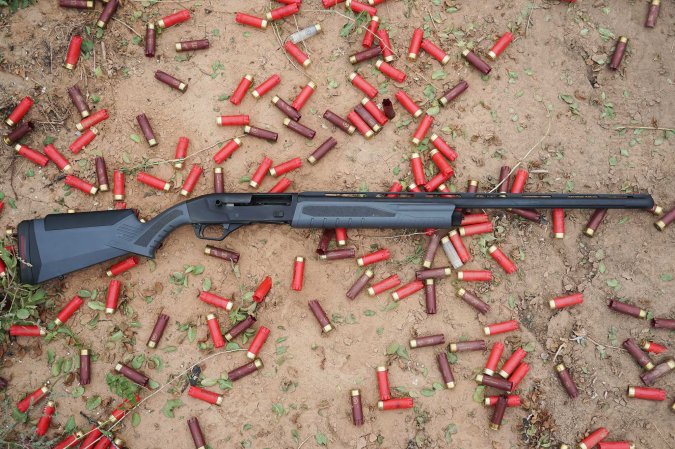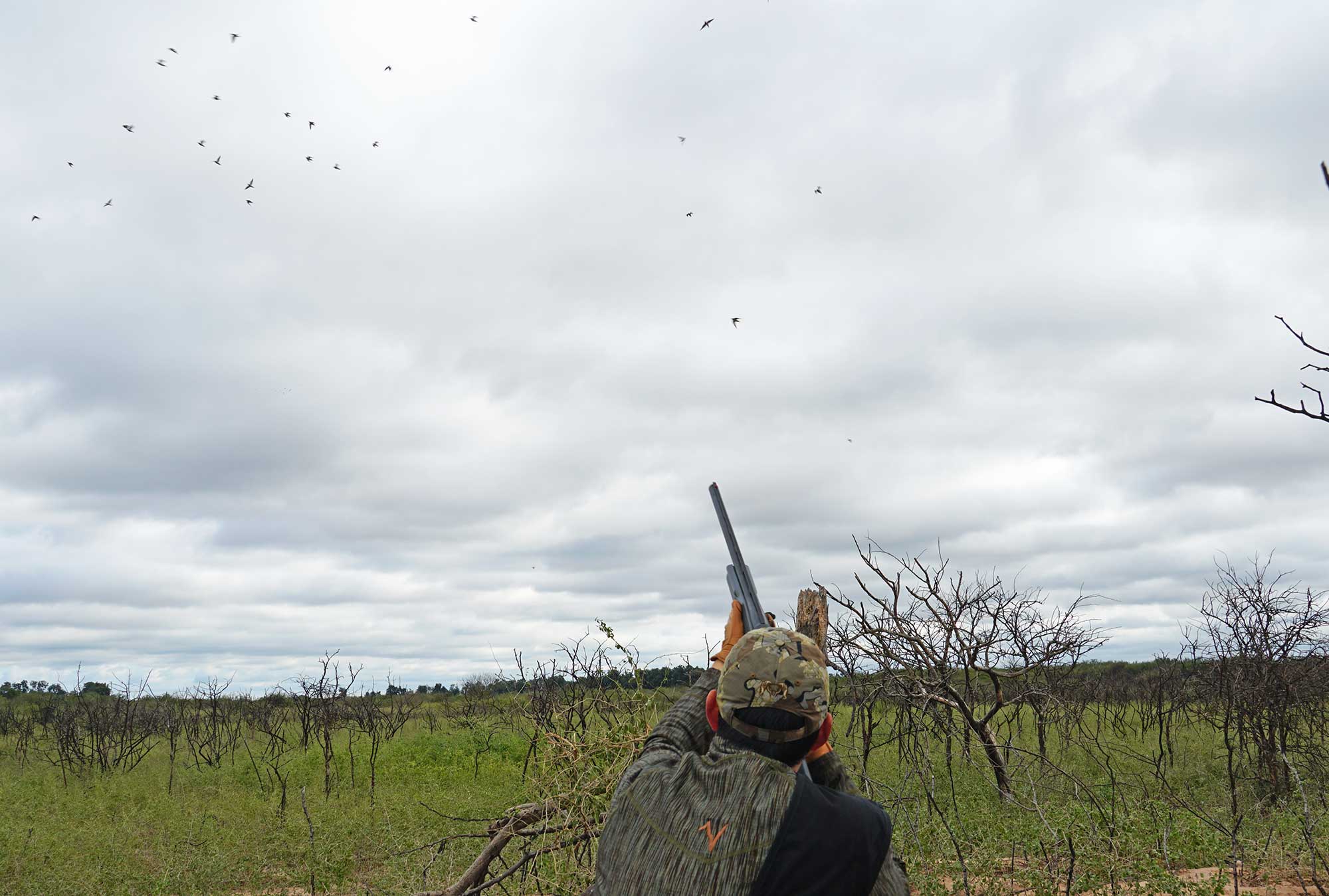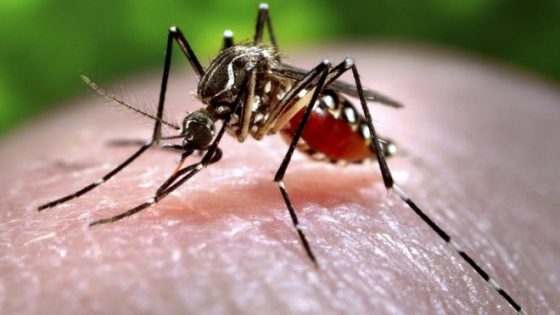We may earn revenue from the products available on this page and participate in affiliate programs. Learn More ›
It was well after daylight as we shuffled to our spots along the brushline. At each post, a bird boy was waiting for us along with two cases of ammo. I imagined we were like machine gunners establishing defensive positions, and as wave after wave of doves washed by, it was clear that this would be unlike any shoot I’d ever experienced stateside.
There were seven of us American bird hunters overlooking a scrubby flat in Argentina’s Santiago Del Estero Province. We had spent two days traveling here, first flying into Buenos Aires (which reminded me of New York City, but more European), then jumping to the city of Santiago Del Estro and taking a good death-defying truck ride into the rural reaches of the province (which reminded me of brush-country Texas, but more South American).
After so many hours spent traveling to get here, I remember being a bit tentative with shooting on that first morning. There was a constant stream of doves flying by, all dipping and diving sporadically. I let most of them pass while trying to make careful, deliberate shots on only the closest and easiest birds.
Then one of my companions, True Pearce, rapid-fired a 10-shot barrage from his extended-tube shotgun. As about six doves fluttered down he let out a loud, “whoo-hoo!” like a big kid might holler before doing a cannonball at a pool party.
Photo by Alex Robinson
Everyone chuckled, especially our Argentinian hosts, who had never met an Idaho cowboy quite like True before. And with that, everyone relaxed and the real wingshooting began. Over the course of the next week I fired thousands and thousands of rounds at passing doves, decoying pigeons, and flushing perdiz. I did some of the best shotgunning of my life. At times I felt like the god of wingshooting, able to strike down any avian species within my shotgun’s reach. But, at other times I fell into familiar shooting slumps.
Through the experience I acquired some good wingshooting perspectives that can probably only be absorbed by firing so many rounds a day at live birds for a week. But I’ll share those perspectives with you anyway, in hopes they might improve your own shooting this fall—or at least provide you some entertainment ahead of another good bird season.

Photo by Alex Robinson
The very first lesson is, if you ever get the chance to take a wingshooting trip to Argentina, you should do it. There are approximately 50 million doves in the country and, because they reproduce so quickly, there are no limits on how many can be shot. I wouldn’t necessarily call it hunting, but it is a unique wingshooting experience. Plus the farmers there see it as a useful depredation tool and the locals like the meat (more on that below). Pigeon hunting in Argentina offers the opportunity for decoying birds and was the most fun of the species to hunt there, in my opinion. Then there’s perdiz, which are upland birds that thrive in grassy habitats around agricultural fields and flush quickly enough to get any bird hunter’s heart thumping. (Imagine if a pheasant and a bobwhite quail had a lovechild, and you’ll get the idea.) And though it was closed when we visited due to bird flu, the country is also known for phenomenal duck hunting.
You’ll Find Your Flow State

Photo by Alex Robinson
Distance runners and fighters will often reference “flow state,” which is the concept of intense focus on the task at hand without requiring effort to focus. There is no self-conscious thought, or anxiety over the outcome. After shooting consistently for about an hour, I was sometimes able to find a sort of wingshooting version of flow state, where I was simply picking out doves and shooting them. I didn’t think about lead, target speed, gun mount, or even distance. I would choose a bird, focus on it, shoot it, and repeat. When I was able to stay in this headspace and focus very tightly on the targets, and the targets alone, I was able to hit eight or more doves in a row. But the very moment I would think about how many I had hit, or how well I was shooting, I would inevitably miss — the magic suddenly broken.
I don’t want to overstate my experience here. Many of the shooters who do high-volume shoots in Argentina fire many more rounds and shoot many more birds than we did. On most dove days we’d shoot 500 rounds in the morning, take a break for a big lunch and a nap, and then shoot another 500 rounds in the afternoon. For reference, according to one Argentinian lodge, the record number for doves shot in a single day is 14,000. This is an absurd number.
A lot of shooters visiting Argentina have their bird boys reload for them — they’ll bring two identical shotguns afield and shoot one while the other is being reloaded. Everyone in our group opted to reload their own guns, but after a few days of gunning I did see the appeal, beyond simple luxury. It’s easier to stay in rhythm and keep your eyes focused on flying targets when you don’t have to reload.
The summary of this lesson is: Think less, focus more on the targets, and you’ll shoot better.
You’ll Shoot with a Sustained Lead

Photo by Alex Robinson
By the third day of pass-shooting doves I realized that I had started using a sustained lead exclusively. My gun would come up ahead of the bird, matching its speed, and I’d continue swinging through until the bird folded. If I missed the first shot, I’d instinctively speed up a little and get him with the second … or maybe third shot. This is different than the swing-through method (or “butt, beak, bang” method) of shooting that many of us are taught as kids. A lot of hunter education content covering the sustained lead describes it as more challenging because you must “estimate the length of the lead necessary to hit the target.” This often results in trying to measure lead or second guessing during your swing, both of which are guaranteed ways to miss.
But, when you’re able to shoot a high volume of targets day after day, the amount of lead comes naturally and it doesn’t feel like estimating at all. Your hands move the gun barrel to where it must go and so long as you keep swinging and keep shooting the bird will fall.

Photo by Alex Robinson
Years ago I hunted with an old-timer in Kansas who had killed an untold number of ducks in his day. At one point, a small flock of gadwall came into our spread and the group shot a few, but not all of them. One duck made it out of the spread and was now flying hard, crossing right to left at more than 70 yards out. We all watched as the old timer raised up and killed that gaddy with a single shot. Impressed, I asked him how much he had led the duck at that far distance.
The old timer looked at me incredulously and replied: “Lead him? I didn’t lead him, I shot him.”
After wingshooting in Argentina for a week, I finally came to know what he meant by that.
Recoil Matters

Photo by Alex Robin
Many shooters who travel to Argentina opt for sub-gauges because they don’t want to deal with the extra recoil of a 12 gauge. Our Argentinian guides all encouraged us to wear shoulder pads so we didn’t get worn out with soreness early in the week.
There are undoubtedly tough guys who will read this and think, “You guys are shooting puny bird loads, what recoil?” But that perspective is a misunderstanding of how recoil impacts your shooting in the long term. Burning through a few boxes of ammo might be no big deal. But when you’re deep into your fourth case of ammo for the day, a little less recoil becomes a real benefit.
With too much shotgun recoil, shooters tend to pull their head off the stock or get inconsistent with their gun mount. With more recoil it can be harder to stay on target for followup shots or to quickly pick up a second target. Most importantly, with heavy recoil, it’s harder to stay in the game and maintain the sharp focus you need to shoot your best.

Photo by Alex Robins
Happily, we were shooting the Savage Renegauge, which I’ve found to be among the lightest recoiling shotguns on the market. The Renegauge is a relatively heavy gas gun with a cushy stock that comes with adjustments for length of pull and comb height so the shooter can fit the gun to them. All of these features make for a wonderfully light-recoiling shotgun.
Read Next: Here’s what Hunters Need to Know About Shotgun Recoil
Heavy Guns Are Easier to Shoot
I’m a big fan of the sub-gauge trend (I just think it’s cool that you can stone ducks with a little 28-gauge). But, there’s no argument here: Generally speaking, heavier shotguns with longer barrels are easier to shoot well. Smooth is fast in shotgun shooting, and heavy guns make it easier to swing smoothly on fast crossing targets, plus the momentum of a heavy gun keeps you moving ahead of the target.
With a 28-inch barrel the Renegauge weighed about 8 pounds, which I’ll admit was hefty for carrying around the field while chasing perdiz. But it was perfect for swinging on doves and pigeons.
Read Next: Savage’s Renegauge Is a Light-Recoiling Semi-Auto Shotgun That’s Made in America

See It
A Tight Choke Is Your Friend
By the second day of the hunt I swapped out my modified choke for a full choke and immediately had better results. Shooting a 12-gauge with a full choke at doves might sound like overkill, but because we were pass shooting a lot of the best shot opportunities were in the 30-yard to 40-yard range.
A 10- or 15-yard crossing shot on a full-speed dove is tough no matter what type of choke you’re shooting. Trying to hit these tight shots on quick targets, I felt a lot like a batter handcuffed by an inside fastball. In other words, I missed a lot of those birds. But with a tighter choke at farther distances, I was able to establish lead a lot more naturally and get comfortable.

Photo by Alex Robinson

Photo by Alex Robinson
When selecting a choke, the best thing you can do is to pattern your shotgun with your preferred hunting load at the distance you expect to shoot the most often. Then go with the choke that gives you the best pattern at that distance.
We didn’t have the opportunity to pattern our shotguns with the Fiocchi lead loads we hunted with (importing ammo to Argentina is extremely challenging). So the best I could do was guess based on field results, and it turned out that a full choke was the ticket.
You’ll Shoot Your Way Out of Cold Streaks

Photo by Alex Robinson
One morning, my buddy Casey Diefenbach and I set up in a little patch of weeds for a pigeon shoot. The Argentinians put out homemade decoys in the cut ag field while we readied our guns and ammo. As pigeons began to circle overhead, it felt a lot like mallard field hunt back home.
The first little flock of pigeons floated down over the decoys and we popped up to cut’ em and … we both whiffed on them all. Our bird boys laughed it off while we reloaded. Next a pair of pigeons did it perfectly and we just barely brought down one of them; after burning through a half box, we had one bird down.
In Argentina, the birds are collected after each shoot (we worked with the bird boys to find all that we could) and then donated to locals. Everyone likes to eat the doves, but wood pigeons are the real treat. Before too long on this morning hunt, there was a small group of people—including mothers and their little kids—lining up on the highway near our field to collect the pigeons we’d surely have piled knee-high when the shot was over.

Photo by Alex Rob
The only problem was we couldn’t seem to hit one of the damned things. I imagined hungry Argentinian children asking their mother why the American from Outdoor Life could not hit a pigeon, and my shooting only got worse.
“Alright, let’s let the next group get in here right and we’ll kill’em. No more missing,” I told my Casey, and myself. And just like that, we did.
For the rest of the morning we picked our shots more carefully and focused on the fundamentals. Unlike the flow state I found in previous days, I now found myself silently repeating an abbreviated shot process: Head down, get in front, just hit one.
Fortunately there were so many pigeons whipping around that we eventually both shot a fair number of birds and regained our dignity.

Photo by Alex Robinson
Because shotgunning is such a mental game, it’s natural to go through slumps, similar to how a great basketball shot might suddenly go on a cold streak. I’ve found the way to get out of a slump is to slow down, focus on the basics, and take only easy shots that I know I can make. After a few hits, the confidence comes back.
You’ll Master Your Toughest Shot

Photo by Alex Robinson
If you want to pad your stats on an Argentina dove shoot, you can zero in on a specific flight path (or target presentation) that is an easy shot for you and take only that shot. There are so many doves in the air flying so consistently, that many will inevitably fly the same line. It’s like shooting the station one low house in skeet all morning, if you’re into that kind of thing.
I was more interested in the shots that were hard for me to make. For years the high-overhead bird has been my kryptonite. I always seemed to swing too fast, or stop my swing (it feels awkward to swing upward), or maybe both.
In Argentina I must have missed this shot 100 times in the first several days. So toward the end of the trip I decided to only take high-overhead shots, and the higher the dove the better. Soon enough I started hitting them, and at some surprisingly long distances. I cannot tell you how, only that I did. (Other, more experienced shotgun writers have good tutorials on this shot presentation.) The visual of the bird and my barrel became imprinted in my brain and, after that, the shot was no longer challenging.
Later that year I killed several ducks with this very shot presentation. I’m certain I would have missed them if I had not experienced Argentina.
Wingshooting Is a Perishable Skill

Photo by Alex Robinson
Sadly, the magic does not last forever. In terms of wingshooting (and life, too), you are who you are. Only with continual and focused practice can you hope to improve.
A year removed from Argentina, if I were to sit in a dove field now, I’d shoot the same way I always do, which is to say pretty average. The god of wingshooting is no more.
But, I’m glad to know the potential for better shotgunning is buried in there somewhere, and it will only take one trip back to wingshooting paradise to rediscover it.
Read the full article here




